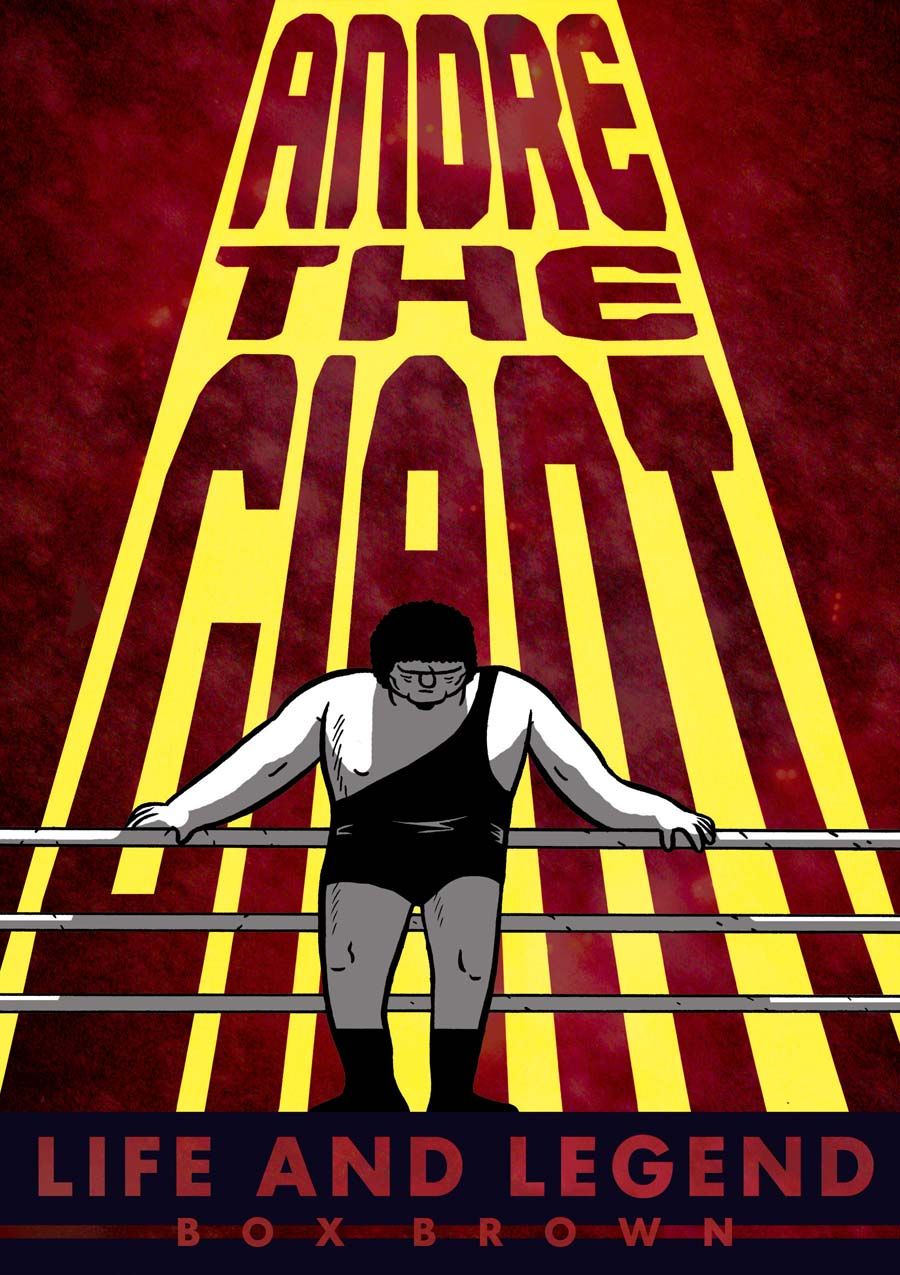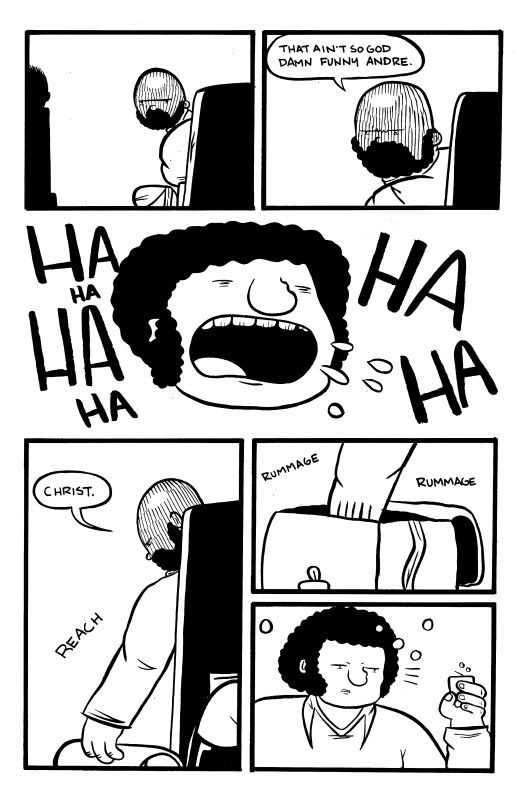Box Brown is a cartoonist best known as the man behind comics like "Bellen," a webcomic collected into the volume "Dizzying Highs and Staggering Lows," and "Everything Lives." Brown is also the man behind Retrofit Comics, a publisher devoted to self-described "floppy alt-comics," which has released works by Noah Van Sciver, Nathan Schreiber, Colleen Frakes, Charles Forsman and many others.
Brown's next major project is something larger than his typical Retrofit work. "Andre the Giant Life and Legend," which arrives in 2014 from First Second Books, is an original graphic novel which details the life and times of tell the story of the titular wrestling legend. Brown spoke with CBR News about the challenge of discerning fact from fiction when researching the iconic wrestler's life.
CBR News: Are you a big wrestling fan? Or were you?
Box Brown: Sure.I got into wrestling around 1990 (age 10) I paid close attention until about -- 2001? Then I stopped paying attention to it for about ten years. I discovered "shoot interviews" a few years back. A shoot interview is an interview with a wrestler where they're out of character and telling real stories from behind the scenes in pro-wrestling. It's a fairly recent phenomenon, since wrestlers were sworn to secrecy about the business of pro-wrestling in the past.
Are you still interested in wrestling? How do you think that it's changed over the years?
When I started working on the book, I revisited the product and have been keeping up over the last few years. It's much, much different from when I was a kid in terms of production. There is no element of improvisation going on the way there was in the past. I think that's got a lot to do with what's lacking in the product today. Improv was one of the finest arrows in a wrester's quiver. The ability to think on your feet in the ring and on the mic was essential. Without that element, it's just a scripted, weird TV show.
What about Andre the Giant made him an interesting subject for you?
What about Andre is not interesting?! He was one of the first worldwide recognized wrestling superstars, but in many ways, he was crippled. He was physically disabled, yet the most powerful man in the world. His story was infinitely fascinating to me, on many levels.
What were the differences for you in creating a biographical story about Andre as opposed to an autobiographical story?
Auto-bio, in a way, is much easier. If you get your own story wrong, there's no real consequence. I mean, unless you're out and out lying. Even still, who would know? When I was telling Andre's story, I had to strike a balance between getting inside someone's head and thinking, "How would they act in this situation?" combined with the facts of the situation.I felt really compelled to try to get his story as close to the facts as possible.
Are there any great stories that you didn't get to include in the book that you wish you could have?
To be honest, not really!There were a handful of stories that got left out but they were lesser stories for sure. There were definitely people I wished I could have talked to that I couldn't get in touch with -- former WWE referee Tim White, who was Andre's friend and road assistant, and Bobby Heenan, to name a few. I sent them letters, called a bar that Mr. White used to own, but couldn't get to him. I even had someone e-mail me saying they knew Mr. White and would pass on my info, but no dice.
There's a story that I've heard, that Andre the Giant knew Samuel Beckett. Is this true?
Well, there's not too much to it -- just that Andre's father had some connection to Samuel Beckett, and at one point Mr. Beckett gave Andre a ride to school. An improvised version of this story appears in the book.It's one of the parts that delves into the "legend" side of Andre.
One of the challenges here -- like in any biography -- is separating fact from fiction/mythology. Considering that there's a lot of mythologizing in wrestling, was it a big challenge in finding the truth and reconciling stories?
Oh, sure.In many ways, it's impossible to get at the real truth when dealing with the world of professional wrestling. The wrestlers would work each other, the people, the promoter, etc. When living in a world where you're paid in cash, you're dispensable -- no unions, etc. -- a pro wrestler will take any advantage they can. This includes polishing stories, even truthful ones, into whatever they need to be. So, even the stories in wrestlers' autobiographies are suspect.
I did my best to parse the information and use my best judgment.I watched an interview with Bill Eadie and Barry Darsow, Ax and Smash of the tag-team Demolition. This was a shoot interview where everything they were talking about was supposedly the truth. In it, Barry Darsow told a story about he and Eadie taking Andre the Giant to a Winery in France and how much he liked it, an almost totally off-hand comment.I had previously interviewed Eadie, as he was Andre's tag team partner earlier in his career, and he never mentioned the trip to the winery, so, I decided to contact him again. Bill said that it actually never happened and Darsow was just telling a story. After that I didn't really know what to believe. I just did the best I could.
Incidentally, this whole project started after I watched a video of Barry Darsow, beer can in hand, in a parking lot, telling a second-hand story about how Blackjack Mulligan once fought Andre the Giant. Darsow's version was quite mixed up, but luckily I found Mulligan had told the story numerous times on video and in print. I also got a chance to chat with him about the fight. He's a wild guy.
Telling a story in a graphic novel is a new experience for you. How did the editors at First Second play a role in shaping the book?
Well, I kind of worked on Andre as if it were a serialized piece at first.They were kind of separate stories about his life in its first version, and I kind of started over from the beginning when First Second got involved. At that point, it was clear that this book must be a true biography.It wasn't so hard. I chunked down the story into smaller stories, filled in gaps where I needed to. It was tricky, but I'm happy with the final product.
Working with Calista Brill at First Second was pretty great. I was living in fear of her edits, but I didn't have any disagreements, really, and I have no doubt that her input made the book a better, more readable story. It was great, too, because she was not really fluent in wrestling history, culture or language which is good. I want this book to be read by non-wrestling fans and hope that they might come away with a new appreciation for the oft-put down pro-wrestling business.
I can't help but think that your style is really well-suited for a story like this. Is this something you thought about or were aware of?
Y'know, I don't know. Maybe being a fan of pro-wrestling has influenced my comic making and storytelling from the beginning?I definitely have an interest in the machinations of things and what makes things work. Working on this book was as much about satisfying a personal curiosity about the history of wrestling as it was creating a comic book.
I think your style is well-suited because so much of wrestling is mythologized and your comics are much more matter of fact. Also, you're very interested in body language. I think those two things are key.
It's funny that you mention that. I found drawing two people involved in some sort of pro wrestling maneuver challenging and rewarding.It's not very often you see people in these strange positions.It's definitely a chance to view and draw the human body in a way you aren't likely to see it every day.
You launched Retrofit Comics in 2011. I'm looking at this as a reader of comics, but it feels as if we're in a different atmosphere today as opposed to two years ago and i'm curious about your thoughts on how things have changed?
Since then, we've seen a rise in subscription-style comics services. I'm not sure if Retrofit completely started this trend, but I'd like to think so -- even though I stole the idea outright from Alec Longstreth's mini-comic subscription service. There's more competition, for sure. We've had a comic shop lower their regular order, and their reasoning: "Sorry man, you've started a trend. Only so much room on the shelves!" which is fine!Competition makes everyone better -- look at late 90's wrestling.
At the same time, I think the audience is growing larger and stronger all the time, and that's not a bad thing. The indie comics convention scene continues to grow at a regular pace. I think the idea of the graphic novel being an artist's only legitimate choice in publishing has definitely declined from where it was in the late 2000's. There was a hole in the market when D&Q, Fantagraphics and Top Shelf stopped publishing cheaper comics with staples in them.I think these subscription, small press services have started to fill that void.
Earlier this year, Retrofit signed a distribution deal with Big Planet. How has that changed what you do?
I'm not a believer in fate or God or what have you, but if I was, I'd say that this pairing was heaven sent, kismet, etc.Midway thru this year, I was not sure I'd be able to continue Retrofit, not because it wasn't profitable, but because of "cash flow." Literally that day, where my anxiety was at its highest, Jared from Big Planet e-mailed me about getting into publishing. I proposed a partnership, and it's been going very well. Big Planet has 4 locations, and Jared thinks of all the important business stuff that I just don't have the mind for. It allows me to focus only on the creative end of Retrofit, and conventions. Oh, also, I don't have to ship 600 floppy comics out of my 9'x9' home office anymore.
What are the plans for Retrofit in 2014? What books and what artists are coming out?
I am very lucky to work with such talented people. Next year we plan to publish comic by Sam Alden, Zac Gorman, Madeleine Flores, Antoine Cosse, Niv Bavarsky, Josh Bayer, Anne Emond, Ben Constantine and Jack Teagle. Also, I'll be doing a comic or two myself.
I was also wondering if you could talk about your recent comics. "Beach Girls" has gotten some nice reviews recently, and "Tower of Power," is one you're selling as a download.
"Beach Girls" was the first comic I did for my publishing house Retrofit.I'd shied away from publishing my own work under that monicker, but I really enjoyed doing "Beach Girls" and working for that format. In 2014. I'll be doing more stuff like that. It was great to work with James Kochalka, too. He was a huge influence on me, especially when I was getting started. We've gotten to be friends over the last few years but I still kind of get nervous around him.
"The Tower of Power" was a story I just started working on and I wanted to work in color. Printing color comics can be tricky, and I'd been thinking about doing a digital release for a while.So I just went for it.It's been an interesting experience. I really like sci-fi, because the story can go in any direction. You're not bound by physical laws or anything.
"Andre the Giant," by Box Brown, is slated for a Spring 2014 release from First Second Books.



